Apple has been busy over the past few years, launching their own chips starting with the M1, followed by the M2, and now the M3. These chips are game-changers for the music industry, giving producers and musicians a serious power boost.
But let's be honest, they've had their hiccups.
You know the drill: a shiny new Mac comes out, but Apple hasn't quite let third-party manufacturers catch up with the fancy new tech. The result? A lot of plugins, interfaces, and Digital Audio Workstation (DAW) software aren't fully compatible yet.
It's a real headache, especially if you've built up an impressive collection of plugins and like to run multiple software applications at the same time. After all, a chain is only as strong as its weakest link, right?
Just one incompatible plugin can cause chaos, and finding the culprit is like searching for a needle in a haystack.
Top 3 - Audio Interfaces for Mac with Apple Silicon
Preview | Product | Price |
|---|---|---|
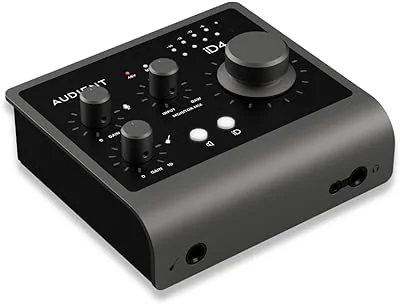 | ||
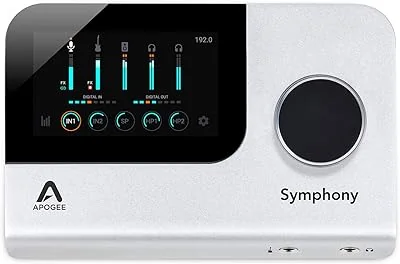 | ||
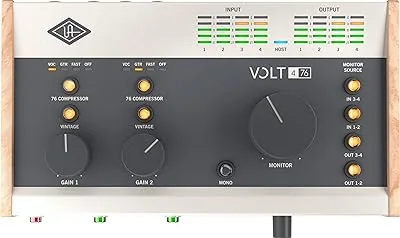 |
But don't worry! It seems like things are starting to look up. With the introduction of Apple silicon, some audio interfaces are starting to benefit.
Here are a few that I've had the chance to test out recently.
Best Audio Interfaces for Apple Silicon - The Top 6!
1. Audient ID4 MkII
The Audient ID4 MKII offers a lot, including compatibility with Apple silicon Macs and the potential for significant impact in the iOS realm. A key enhancement in this audio interface, vital for live performance production and recording, is reduced latency.
Audient has prioritized accelerating its USB 3.0 transfer, claiming it to be 10 times faster than the previous version. This improvement is crucial as it enables recording at lower buffer sizes, fully leveraging the power of the Mac silicon chip.
Audio interfaces, especially, benefit from the Apple silicon chip due to their use of buffers in tandem with the chosen DAW, minimizing the delay between initiating and running the transport and reducing 'round-trip latency.'
'Round-trip latency' describes the speed at which you hear your input monitoring signal after playing or singing a note. The latency response of the Audient impressed me considerably.
The ID4 features a convenient knob that allows nearly simultaneous switching between input and playback monitoring, a function that significantly benefits from lower buffer sizes.
It also boasts an excellent 600-ohm headphone amplifier, but unfortunately, it is limited in terms of inputs.
I tested it on a MacBook Air M1, a Mac Studio M1 Ultra, a Mac Mini M2 Pro, and a MacBook Pro 14-inch with an M3 Max. There was little difference in performance between the M2 Max and M3 models.
The M1 model performed admirably with moderate plugins in the session, but I noticed a slight CPU peak when integrating some U-He Virtual Instruments.
The MacBook Air's fanless design was a drawback, as it struggled with power throttling when it began to heat up, resulting in a noticeable lag after a few hours of usage.
2. Apogee Symphony Desktop
Apogee is known for its superior converters and timing technology. I once owned their Big Ben master clock, which significantly reduced jitter in my ProTools setup. However, when I transitioned to Symphony, I noticed a significant improvement in sound quality.
This high-end system boasts a premium 24-bit 192kHz conversion. It's unique as it's one of the best interfaces for an Apple silicon Mac.
While it works with any DAW, Apogee designed it with Logic Pro X in mind. The integration with Apple's Logic Pro X is exceptional.
Its ability to smoothly operate and record 10 inputs simultaneously is unparalleled for an interface of this size. It also features an innovative technology, DualPath Link, which allows zero-latency tracking through plug-ins, almost as if you were using analog gear.
It performs exceptionally well with Apple silicon chips. I tested it on an M1 chip with a MacBook Air, and I managed about 85 tracks with a 64 buffer size and numerous Waves and Izotope plug-ins before reaching my limit.
With the M2 chip, I could increase the track count, including several VST Synths. However, I faced issues when I used it with a Mac equipped with the M3 Max chip.
The issues with the M3 chip were related to running native plug-ins, not DSP. These worked flawlessly with M1 and M2 machines.
After researching online, I found that some drivers are not yet fully compatible, as this interface has DSP enhancement. You can either run Apogee plug-ins natively or use DSP versions, just like you would with ProTools HDX or Universal Audio plug-ins through the Apollo system.
Like the Universal Audio Volt, this interface also includes a mic preamp emulation by the legendary Bob Clearmountain, which adds a touch of solid-state grit to your sound.
3. Universal Audio Volt 476
The UA Volt 476 interface boasts impressive features. However, I encountered some issues when using it with my older Intel MacBook Pro. Notably, I experienced a troublesome crackling sound during real-time recording with the UAD console when the buffer size was set below 128.
Larger buffer sizes can cause latency issues, particularly when tracking vocals. These problems were resolved when I transitioned to Apple silicon. However, they reemerged with the latest Mac OS Ventura version, where certain UAD native plug-ins produced white noise distortion.
According to the compatibility chart and customer support, the latest versions of Ventura and Sonoma are still under beta testing and not fully compatible. Support for the M3 chip isn't officially available yet but is expected by year's end.
The Volt 476 offers unique features, such as a vintage preamp circuit for the classic 610 tube preamp sound. Its stellar 192 kHz sample rate conversion provides a clean, clear, and wide sound.
If you can delay upgrading to the newest operating systems and Apple silicon chip M3, you'll experience no issues using many UADx native versions of the plug-ins. The interface also includes Ableton Live Lite and various Plugin Alliance and Softube plug-ins, which are fully compatible with M1 and M2 chips.
4. Focusrite Scarlett 4i4 (4th Generation)
I've recently been a guest on several podcasts and have noticed that the Focusrite Scarlett 4i4 is a common feature in many studios I've visited.
Its popularity can be attributed to its secret weapon for enhancing voice quality. It boasts top-tier converters and a unique "Air Mode" feature, which adds a sheen to any input or instrument.
The device shines particularly with vocals and performs better with the M1 and M2 chips.
However, it does have drawbacks. For example, the USB 2.0 connection is somewhat slow compared to other interfaces, as evidenced by error messages I received about lag during intensive podcast editing sessions.
Despite using a MacBook Air with an M1 chip, I experienced some recording issues. Initially, I thought the CPU was overheating — a common problem with MacBook Airs. However, the same issue occurred with a Mac Studio equipped with an M1 Ultra chip.
Fortunately, the new Mac OS Ventura update appears to have resolved the problem, and I've had no issues recording to my internal drive since.
Most professionals recommend recording to a Thunderbolt drive rather than the internal drive, especially when using Pro Tools. However, as I frequently travel with my Scarlett interface, I find it more convenient to record to my internal drive.
If you're considering using an interface at 192 kHz with an Apple silicon laptop, ensure you have at least a 512 GB internal hard drive. I recommend opting for a whole terabyte if your budget allows.
It significantly improves stability.
5. SSL 2+
The SSL 2+ is my absolute fave when I'm jamming live with my Synth rig. I've got a mix of virtual instruments and synths set up, all my presets ready to roll, and even some pre-recorded stems and clips of analog synths from the studio.
What really gets me about the SSL 2+ is the killer sound quality and its low noise. Even though it's more of a budget option compared to other SSL stuff, it doesn't skimp on the converter quality.
I'm totally into the SSL 4000 circuitry, which just vibes perfectly with my hardware setup. But, one thing about SSL that can be a pain is their software debugging can take a while.
Switching over to Apple silicon chips has been a bit of a headache, as SSL can be a bit slow on the uptake. If you get a new Mac with the latest OS, you might be waiting a while to use your interface.
Like, right now, this interface doesn't play nice with Sonoma, and I had some issues with the M1 Mac and Ventura.
But, M1 and M2 Macs running Big Sur seem to be pretty stable now. So, if you're thinking about getting this interface, maybe hold off until it's fully compatible, or don't upgrade your operating system for a few months after getting your new computer.
The SSL 2+ is a pretty straightforward interface with 2 inputs and 4 outputs, and it uses USB 2.0 for data transfer. The performance difference between the M1 and M2 chips isn't really a big deal. However, it doesn't offer the best round-trip latency, which I noticed while recording vocals. Despite this, its excellent sound quality makes it an ideal choice for a monitoring interface.
6. Arturia AudioFuse 16
The Arturia Audiofuse 16 is an excellent interface poised to be the heart of your studio. Imagine this - it offers numerous routing options, all done in a matrix-style, DSP setup right from the unit itself, akin to the original SSL Sigma systems.
The sound from this interface is absolutely amazing. The ESS and Cirrus Logic converters add a ton of clarity and a really big, pleasing sound.
This interface is no joke; it's a powerful beast that can record 8 channels at 96kHz or 16 channels at 48kHz. Plus, it's enhanced by the power of Apple silicon chips.
When I tested it with an M2 MacBook Pro, I could add 24-bit 192kHz resolution recordings without a hitch, even when tracking several inputs simultaneously. The interface maximizes the power that Apple silicon has to offer, allowing you to use multiple instances of Arturia's virtual synths and effects.
Compared to when I used my HDX system on my Intel tower, where I could only run about a quarter of the Arturia instruments and effects that I can on my MacBook Air M1.
I'm not sure if this is because Arturia's hardware interface works so well with their software or thanks to the power of Apple Silicon, but the result is pretty mind-blowing.
My ultimate test is running Ozone 10, fully maxed out with oversampling. The M1 chip-equipped MacBook Air and Mac Studio handled it at around 512 buffers. The M2, however, allows 4 times the instances at 128 buffers.
I wasn’t able to test the M3 chip unfortunately, but I’m guessing it extends it even further barring any software compatibility issues.
I usually opt for this interface when I'm doing orchestral mock-ups and heavy MIDI programming, especially when I plan on using a bunch of Arturia's soft synths.
Choosing the Best Audio Interface for Apple Silicon Macs
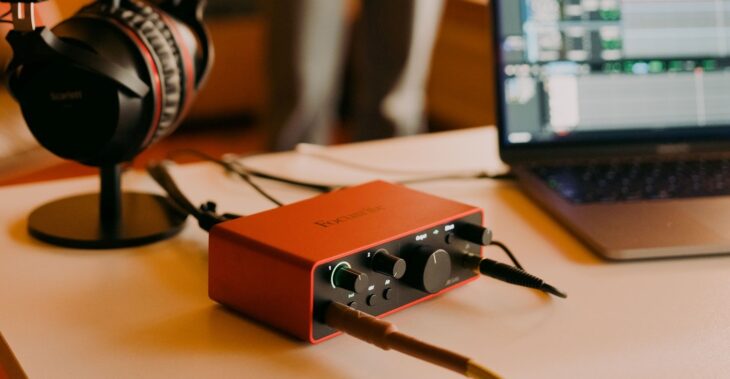
There's no arguing that any of these interfaces, mixed with the incredible power of new Macs equipped with Apple’s M-lineup of chips, can elevate your music production to professional levels.
So, what might tip the scales for you in choosing one interface over another? Let's discuss the four reasons that influenced me.
Compatibility
You know, some companies are just better at rolling out software updates, plug-ins, and drivers than others. Maybe it's because they've been around the block a few times and know how to handle the curveballs Apple throws when they push out something new.
And let's not forget about the big guns. Some companies have the clout to get their hands on the latest Macs to test way before anyone else.
Take Universal Audio and Apogee for instance. They've been in the game so long they get special perks, like beta testing new Apple software. Might be worth going with one of their interfaces just to save yourself some headache, you know?
Latency
Latency becomes a significant issue when recording and monitoring through the same interface. DSP-enhanced engines, such as those from Apogee and Universal, often have superior performance in this area. These engines leverage the internal DSP power of the interface to provide almost zero latency response during recording.
Apple silicon chips generally improve track count and the functionality of complex software and plugins. Buffer size is slightly critical when tracking live instruments or vocals in real-time, and it seems to have a larger influence on MIDI timing.
Interestingly, even the benchmark differences among M1 Pro, Max, Ultra chips, and their M2 equivalents don't significantly alter hardware interface latency issues. They will impact how much your CPU is utilized when running software, Virtual Instruments (VI's), and plugins.
The interface is affected when you aim for the lowest buffer size to track. The lower the buffer, the greater the CPU usage.
USB Transfer Speed
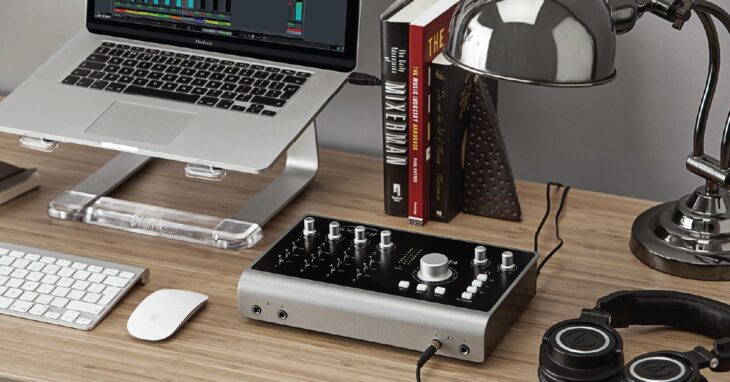
Many interface USB transfer speeds appear quite similar on paper. However, those utilizing USB 3.0 are worth a second look, especially if you plan on integrating more iOS devices with your M-chip series Macs.
To thoroughly assess USB transfer speed issues, it's necessary to push these interfaces to their limits. The first signs of bandwidth maximization appear as pops and crackles in the audio.
This could be due to incompatible drivers, SSD drives that lack sufficient space, or in rare instances, excessive DSP usage on heavy Plug-Ins, such as Izotope Ozone.
Bundled Software
It's kind of cool how even the less expensive interfaces include a bunch of free software. Sometimes, the software alone is worth the price tag.
Sure, sound quality and stability are the main considerations when choosing an interface. However, the software that comes with it can also influence your decision, depending on your needs.
Apple silicon lets you run more software simultaneously. With about 90% of plug-ins needing native CPU power, new chips like the M2 and M3 are pretty awesome.
These chips are really good at using memory efficiently, allocating GPU resources, and handling DAW processing priorities. So, if you've got the cash, going for the latest chipset is a no-brainer, as long as the software companies make sure everything's compatible.
Final Thoughts
The biggest game-changer with the Apple silicon chip? It kicks DSP-enhanced hardware to the curb. If you can get it without shelling out a ton of cash, and it does what you need it to do, then yeah, use the extra DSP. But it's not going to make or break your decision.
We've all been there, getting sucked into the high costs of DSP-enhanced hardware. I've been there too and got caught in their trap.
I remember when I upgraded to ProTools HDX, which set me back a cool $6000 just for the upgrade. Then I had to fork out another $2000 for a Universal Audio Octa Core card just to run their plugins.
I even bought an SSL Duende to use the SSL plugins that were around at the time. All in all, I dropped $10,000 to build a rig that's only half as buff as running the same setup natively on an M2 or M3 Enabled Mac. And that didn’t even include the computer itself!
Now, at a quarter of the price, you can get an interface that's four times as fast and in most cases, also portable and great sounding. What more could you ask for?

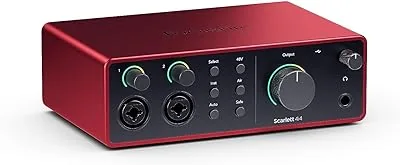
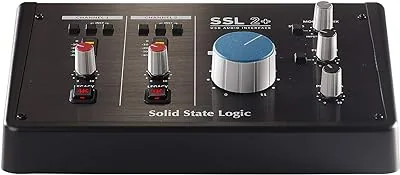
Hi Tomas, excellent write-up, thanks! While my son plays guitar, we also have a superior CD player with both optical and coax outputs. We’d like to use that (instead of the Apple Superdrive) to import CDs at AIFF quality to the Music app. Do any of the ones you reviewed (with the appropriate I/O) have the ability to do that?
Thank you!